The big screen big budget adaptation of THE AVENGERS kicks ass at the box office around the world, uniting many of Marvel’s big screen heroes after their solo cinematic outings in what has to be one of the most highly anticipated movies of recent years. We’ve thrilled to the big screen adventures of Iron Man, Thor, The Hulk, and of course Captain America who was given the big screen treatment in last year’s big budget adaptation directed by Joe Johnston (The Rocketeer).
This time, Chris Evans donned the mantle of Steve Rogers /Captain America, in his second Marvel superhero in less than a decade, having played Johnny Storm the Human Torch in the two Fantastic Four outings.
We thought it was time to look back at a time when comic book adaptations were sadly often not given the budget or support to really break out.
More than 20 years ago, Captain America hit the screen at least in certain territories with cult director Albert Pyun at the helm, and Menahem Golan as Producer. Forces of Geek’s Man from Hong Kong Big Mike Leeder takes a look back at Albert Pyun’s take on the first Avenger and then speaks to both Pyun & Producer Tom Karnowski about the film.
 |
| The Red Skull: You remain a poor choice, little brother. Captain America: Stop calling me your brother! |
The film introduces us to a frail young man named Steve Rogers (Matt Salinger), whose patriotic spirit is caged by his frail body, classified as unfit for military service in World War Two. Given the chance to volunteer for a secret government experiment to create physically enhanced soldiers, he quickly accepts and is transformed into the enhanced human the world will know as Captain America, a fighting symbol for freedom and independence. His first mission sees him parachuted into Germany to prevent a huge missile being launched at the White House, but a trap has been set and waiting for him is his Axis counterpart, the Red Skull (Scott Paulin).
The two face off and Captain America soon finds himself strapped to the rocket bound for Washington, at the last moment he is able to knock the missile off course and it crashes into Antarctica where he remains frozen for 50 years. Awakened in the 1990’s, he discovers that the Red Skull is still very much alive, operating under the guise of a wealthy businessman, he controls a vast criminal empire and has been responsible for the much of the world’s troubles, pulling the strings that have affected the people of the world and masterminding the assassinations of various public figures including John F Kennedy and Martin Luther King. When the Red Skull kidnaps the American president (Ronny Cox) planning to implant a mind control device, Captain America must face off against his opponent for a final battle.
I had high hopes for the Captain America movie when it was first announced.
I was a big fan of Albert Pyun since The Sword & The Sorcerer, and he’d gone from strength to strength as a director, helming everything from post-apocalyptic road movie Radioactive Dreams to Jean-Claude Van Damme’s Cyborg.
The first pictures released from the film really got me excited. Granted, the Captain America costume didn’t look as cool as hoped but the pics of Captain America and the Red Skull duking it out in front of a huge missile emblazoned with the Nazi symbol looked as if they’d be torn from a Jack Kirby comic book.
But the budget restrictions imposed on Pyun and his team cut the legs out of the project, there’s so much potential but so little chance to explore the ideas the film introduces on the scale it needs. Matt Salinger (Yes, he’s the son of a certain JD Salinger) brings an interesting ‘aw shucks’ kind of naivety to his portrayal of Steve Rogers/Captain America, that captures the innocence of Steve Rogers and the fierce patriotism of the character.
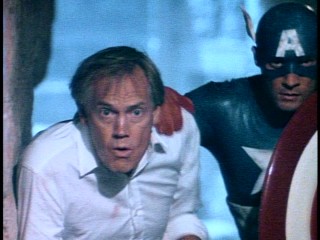 |
| Captain America: Gee whiz, we gotta get going, Mr. President.’ |
Scott Paulin delivers a great take on the Red Skull (OK, we’re still not 100% sure why they did it, and I still don’t agree with the idea of changing him from a German to an Italian!), a sarcastic psychotic who had his childhood and innocence snatched away and became the evil mirror to Captain America’s character.
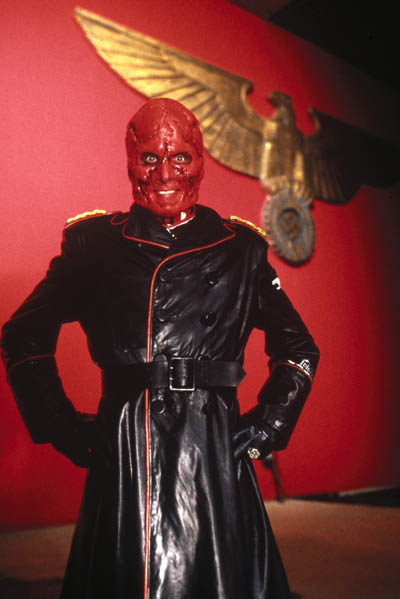 |
| The Red Skull: [on seeing Captain America for the first time] Good, an American. Just when I am needing help of my English lessons.’ |
Kim Gillingham does double duty as both Steve Roger’s wartime romance Bernice and her feisty daughter, both of whom fall for and have their lives changed forever by their encounters with the title character.
Ronny Cox from Robocop seems to be having great fun playing the President of the United States, having a very brief encounter with Captain America as a child which he carries with him until they meet again. The great Ned Beatty also delivers as the President’s childhood friend–turned news reporter, Sam, whose thirst for a good story eventually costs him his life. The cast is rounded out with such familiar faces as Michael Nouri, Melinda Dillion and Bill Mummy as the younger version of General Fleming, played as an older scheming official by Darren Mcgavin in a performance close to his Dead Heat scene stealer.
It’s a flawed film, mostly because of the insane budget cuts and limitations imposed upon Pyun and his long time producing partner Tom Karnowski, but it’s also highly entertaining. Watching the first footage from the new Captain America movie with Chris Evans as the title character & Joe Johnston at the helm, I find myself thinking how familiar so much of the film looks to Pyun’s version, as if Johnston and company used it as a blueprint and have been given the opportunity to make the film they wanted with a budget that Pyun could only dream of.
The film received a very brief UK theatrical release and was released on VHS & Laserdisc, but there’s been no official DVD release of the film as yet (it is available commercially in the United States via MGM’s MOD) although we’re looking forward to seeing Pyun’s directors cut of the film (which could feature 27 minutes of unseen footage) hitting the screen shortly.
_________________________________________________
Armed only with their enthusiasm and a budget that would barely cover catering on the new version of Captain America, Director Albert Pyun & long time Producer Tom Karnowski talk to me about the battles they fought to bring the first Avenger to the screen in 1990.
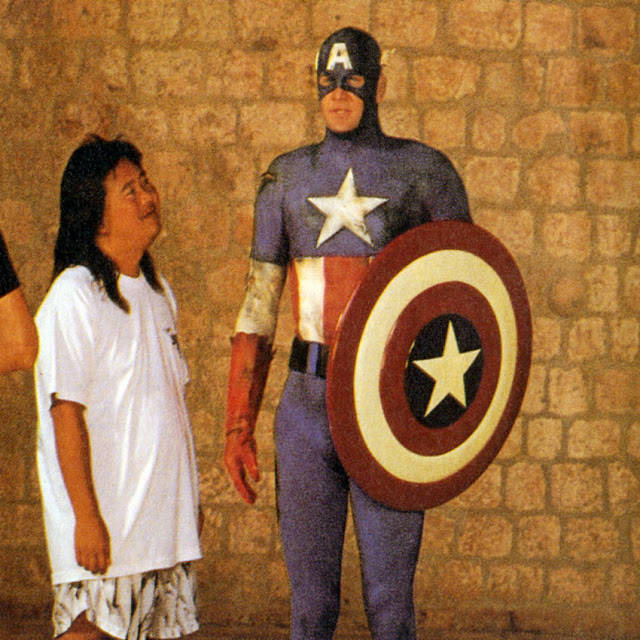 |
| Pyun on set with the Captain, himself! |
Big Mike Leeder: Now Albert, you were originally slated to direct another Marvel superhero film before this, what happened that switched you to Captain America?
Albert Pyun: I was supposed to direct Spider-Man for Cannon films, but there was a last minute rights issue and the option was lost. I knew that Cannon had Captain America too, I was a big CA fan and everybody kept saying that Stephen Tolkien’s script for the movie was really great, and when I got to read it I agreed, it was. So when Menahem Golan was splitting from Cannon, I lobbied for him to bring it with him to his new company 21st Century, then I heard that the option on that was expiring too, so I went and pitched my take on the project and he gave me a very quick green light to shoot the movie in Yugoslavia. I was very excited, but the promised production funds never really materialized and it impacted the film in a lot of ways.
Like I said, I grew up on the Kirby comics and just loved the tragic aspect of Steve Rogers’s life. I just wanted to be faithful to the character I remembered growing up with. I was coming off Cyborg which was a disappointing experience and wanted to do a straight ahead movie without a lot of artistic frills which had sunk my Cyborg version.
How challenging was it to try and bring this character to life — and in period to boot — with what I’m sure was a very limited budget?
AP: Very challenging.
My initial concept had been to have two actors play the character, one before the experiment, one for after. I had discussions with American Football star Howie Long (who would later make the move into film with Broken Arrow and Firestorm) about playing the later version.
But Marvel nixed the idea saying that it had to be the same actor for the whole movie. Marvel and Stan Lee had a lot of creative say in the process, initially I didn’t like the way the Captain America blue suit was looking in tests, so I petitioned to use the CA black uniform, or at least to be allowed to modify the look a little, but they turned me down.
Menahem was great, he supported me on everything I wanted to do but I think that Marvel didn’t like the fact that Menahem was making the film so they were difficult at times. I did meet with Stan Lee and he was very nice and supportive of the project, and we discussed having him cameo in the film.
We couldn’t have any very big action scenes! That’s for sure. It was a struggle throughout and we even ran out of film one day shooting a scene with Michael Nouri in the rest home, I had the camera operators turn off their cameras out of film alarm and kept shooting.
Was it sometimes disheartening to be given a project like Captain America to produce, and then have the budget constantly re-adjusted?
Tom Karnowski: I don’t remember it being constantly adjusted but I know we only had something like US$6 million to make the movie and that it obviously needed more to be done right.
It’s a shame because it was really a good script that Tolkin had put together. I don’t remember how much budget we were supposed to have but at some point it became clear that the $6 million figure was the bottom line, and we knew well enough how things worked at that point to know that it was what it was and we were just going to have to find a way to make it work with what we had.
Was it a budgetary decision to film so much of the movie overseas?
TK: The script required both the US locations and Italian ones like the castle, etc, that we were able to find in the former Yugoslavia and obviously we got a lot more bang for our buck by shooting there.
So we did as much as possible there, it was our first time shooting in Europe and frankly I loved it and I think Albert did too.
Later on we did a lot of shooting for our other films in Slovakia using a lot of the key crew guys from Captain America, and for this I gained a reputation for being the go-to-guy for production in that part of the world.
How did you view the character of Steve Rogers, both before and after the super soldier serum is used on him. How would you describe the man before and after he becomes a superhero? Was that something you would have liked to explore further in the film?
AP: I can’t say if my Captain America Director’s Cut is better but it’s definitely WEIRDER and more subversive.
It really deals with the issue that Steve Rogers discovers that he was a hero and super soldier WITHOUT the drugs. That those qualities are within him and it doesn’t take a uniform and shield to make him super heroic. That’s what Rogers explores in my DC. That’s why those scenes were removed from the 1990 release version.
There’s a great scene where the character played by Tommy Lee Jones in the new version and Michael Nouri in my version, decades later tells Rogers that the super soldier was always in him (Rogers).
Implying that the serum was really a super charged placebo. And what made Rogers unique and why he was the only super soldier was because he was the only real Captain America in his heart and soul. those other super soldier candidates failed because the serum’s enhancement warped their sense of right and wrong and they went bad. Hope you will like my subversive take on the Captain America myth.
What would you say are the major differences between the original version and the version that was released…will we ever see the Albert Pyun cut of Captain America?
AP: I have my version sitting in storage on 35mm print and 35mm full coat mag. Yes, we are re-mastering it now and it will be screened beginning in June sometime.
The big difference is focuses more on character and doesn’t try to be the big action tent pole, which it isn’t. It runs about 124 minutes. So it’s much longer. There are a number of scenes showing Steve Rogers coming to the realization that he was always a hero and super hero within and he wasn’t just a hero because of the costume and some serum.
More on his compassion for the Red Skull, how he realized they were the same in most ways.
Did you want to explore the ‘relationship’ between Captain America and the Red Skull? In the movie the Red Skull mentions it in passing, ‘my American brother’.
AP: Oh yes, I loved how they were essentially brothers born of the same experiment. One warped by it, the other liberated.
What I loved was how Cap understood and sympathized with what happened with the Red Skull as a boy and saw him as a tragic victim of Nazism instead of an arch villain. He knew the Red Skull was driven by bitterness and rage about his childhood tragedy. Captain America was humane enough to understand this. Both endured tragedies and lost loved ones.
And it wasn’t going to take muscle and bullets to stop the Red Skull but by getting him to confront the past.
What are your strongest memories from the production?
AP: Strongest memories were sweating out whether there was enough cash to get through the day. Best memory was working with such terrific actors as Ned Beatty, Michael Nouri, Ronny Cox, Melinda Dillion and Darren McGavin. Billy Mumy was a blast. And I really enjoyed Francesca Neri, Matt and Kim Gillingham as well.
Everyone tried hard under terrible circumstances. And of course it was a marvel to witness Scott Paulin’s awesome performance each day after enduring 6 hours of make up by the great Greg Cannom!
When you see the budget being given to the new version of Captain America, what goes through your head and if you could work with a budget like that, how would you do things?
TK: Well, I would love to have the opportunity to produce Tolkin’s script again but with a huge budget. It was a great script and the pinched production we had didn’t do it justice. But it was a different time then and this is just how things go.
All I can say is I really hope that the new one is working with as strong a script as we had.





































































































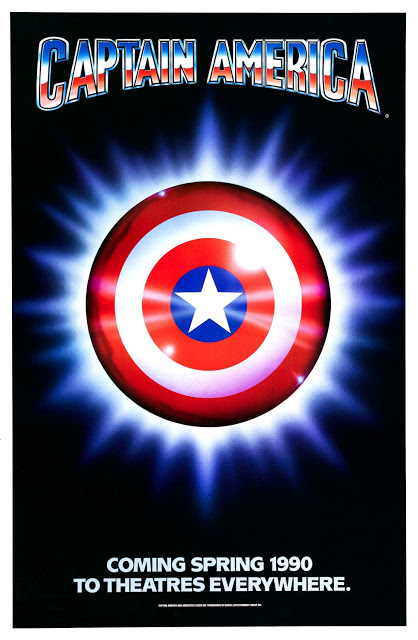
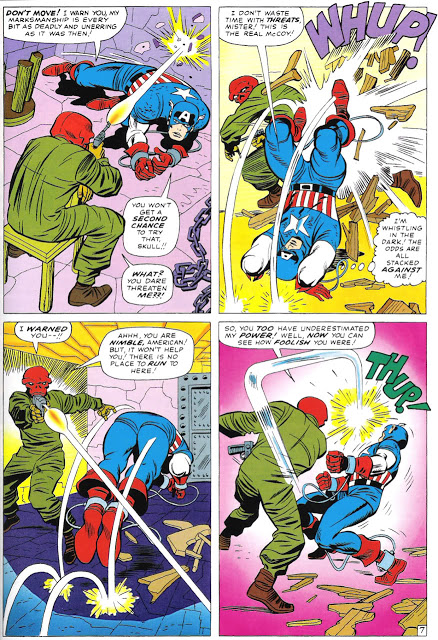
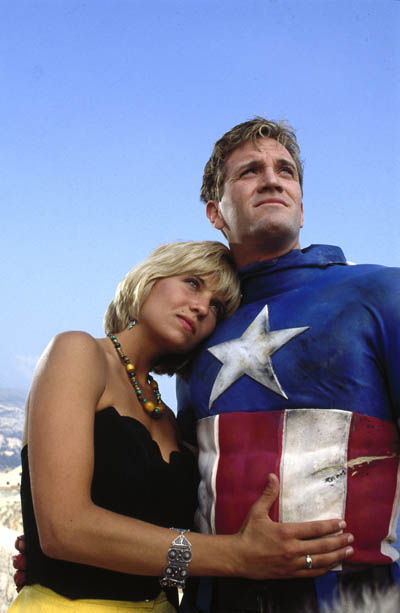







Pingback: 242. Captain America (-#65) | the m0vie blog – Social Media Post